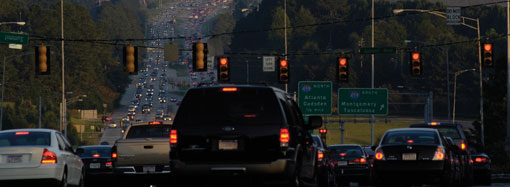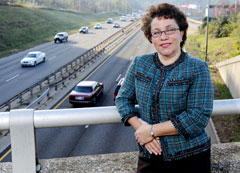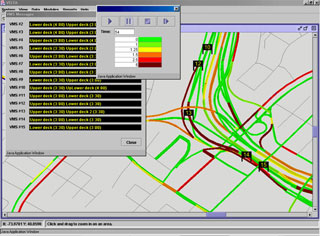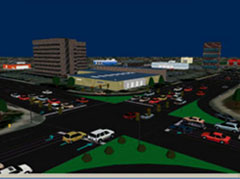A Free-flowing Conversation with UAB’s Dr. Gridlock
By Matt Windsor

Everyone likes to complain about traffic. UAB transportation expert Virginia Sisiopiku, Ph.D., is actually doing something about it. Sisiopiku, an associate professor in the Department of Civil, Construction, and Environmental Engineering, is following several parallel lanes of traffic-related research that could lead to a quicker, happier, healthier commute for the rest of us—without years of paralyzing construction.
 UAB transportation expert Virginia Sisiopiku creates 3D digital replicas of local roadways to help tame traffic."In the past, the answer to traffic was to build new roads and add new lanes, but we have come to the conclusion that this does not work,” she says. “Eventually, your money and available space run out, and the traffic is still clogged. We are looking at ways to reduce traffic congestion and the consequences—everything from increased travel times to pollution—without building more infrastructure.”
UAB transportation expert Virginia Sisiopiku creates 3D digital replicas of local roadways to help tame traffic."In the past, the answer to traffic was to build new roads and add new lanes, but we have come to the conclusion that this does not work,” she says. “Eventually, your money and available space run out, and the traffic is still clogged. We are looking at ways to reduce traffic congestion and the consequences—everything from increased travel times to pollution—without building more infrastructure.”
Here is a quick spin through the science of traffic research—and four potential solutions being pursued by Sisiopiku and other researchers at the UAB School of Engineering.
SimInterstate
Like any scientist, Sisiopiku yearns to test the latest traffic theories in the real world, but that is just not possible in her line of work. “Transportation projects are extremely time- and cost-intensive,” she says. “We can’t just go out and lay down a new lane to see if it works. We have to determine the potential impacts of that new lane well ahead of time, and to do that without any traffic disruptions we use simulation modeling.”
UAB engineers have spent years refining highly detailed models of the local roadways, capturing everything from the peculiar twists of Highway 280 and the relatively high number of trucks operating on Interstate 65 to the lane-changing predilections of Birmingham drivers. “Traffic is much more complicated than it seems,” Sisiopiku says. “We construct the environment and flow patterns as realistically as possible, and then we run our models and collect the results: how many vehicles get through the system, travel times, traffic delays, and pollution measures, to name just a few.”
Using field data, the researchers calibrate their digitized roadways to match real-world operations. Then they start tweaking, measuring what happens when they add a lane or make other changes in network geometrics, traffic control, or vehicle demand. The more sophisticated models offer 3-D visualization capabilities that can animate the results of the simulation. “The 3-D aspect doesn’t change the results, but it definitely gets the public and elected officials more interested when they can experience it firsthand,” Sisiopiku says.

While some of her research is focused on the present, “part of our work is also to forecast what the situation will be like in the future,” Sisiopiku says. She notes that UAB has a strong relationship with the Regional Planning Commission of Greater Birmingham. “We help them collect and manage traffic data for the region, which is very important in any study,” she says. “We look at expected changes in demographics, plans for new residential and commercial developments, and business relocation trends to determine if the existing transportation network can continue to serve the community needs in 20 years. Then we make recommendations on required changes in the transportation infrastructure in our region to accommodate those changes in travel patterns.”
Solution 1: Shift the Clock
“One possible way to reduce traffic demand is to change driver behavior,” Sisiopiku says. Businesses can be encouraged to allow workers to telecommute, or to institute rolling start times, she explains. “Many of the people who work in downtown Birmingham start at 8:00 a.m. If employers allowed flexible work hours, workers would save time and cost during their commutes—and traffic congestion during peak hours would decline as a result. I believe we should and could get more creative in order to better distribute traffic over time and space.”
Drivers could also be encouraged to run errands during off-peak times rather than at the height of rush hour. “People will make better decisions if they are better informed—and sometimes just a small shift in the number of users to another mode of transportation, or no travel at all, can make a huge difference,” Sisiopiku notes. “In our models, as traffic volumes increase, we see speeds remaining constant up until a certain point, and then there's a dramatic drop. If we can keep traffic below that point, everyone will benefit.”
Solution 2: Double Up
Another proven traffic-beater: carpooling. “I realize it’s not easy to give up the freedom of driving, but it’s good for everyone to start thinking about how they can change their travel choices to contribute to less traffic congestion, less fuel consumption, and less pollution,” Sisiopiku says.
|
In the past few years, the School of Engineering has joined with researchers at other UAB schools to develop a comprehensive trans-disciplinary, multisystem measurement model to understand the underlying social determinants of public health. Virginia Sisiopiku is studying the impact of transportation system design and travel options on obesity and other health issues for different populations. “We have proposed a methodology to measure the quality of neighborhood attributes—if it is walkable and if there are bikeways, transit options, properly maintained pedestrian facilities, and those sorts of things—and establish their potential correlation with health outcomes,” Sisiopiku says. “We have selected two communities in Jefferson County for a pilot study, with the goal of eventually being able to apply this to any community.” In another study, UAB engineers are examining the physical and economic benefits of public transportation. “We want to find out the health impacts, as well as the economic and environmental impacts, of introducing transit options into communities that don’t have them,” Sisiopiku says. It’s a concept that is working well in many cities, she says, with benefits to both the city’s bottom line and the health of its citizens. “Research shows that if people take public transit to work, then they spend a median of 19 daily minutes walking, which nearly achieves the target of 22 daily minutes of moderate physical activity recommended for staying healthy. Drivers on the other hand only walk an average of about six minutes daily,” says Sisiopiku. The way communities are designed—and the available transportation options—are inextricably linked to the amount of physical activity that residents engage in, Sisiopiku notes. Shifting from an automobile-dependent society to a society that embraces a variety of transportation modes should help address two fronts: alleviating future congestion problems and improving public health at the same time. Honk if you agree. |
One concrete way to encourage drivers to use the buddy system is the high-occupancy vehicle (HOV) lane. “This can be a new lane or even an existing lane that is converted to only allow vehicles with two or more people,” Sisiopiku says. UAB researchers have studied the impact of HOV lanes and similar measures on Interstate 65, Birmingham’s main traffic corridor.
“HOV lanes have worked well in other cities, either by themselves or in conjunction with a toll system in which single-occupancy cars are allowed to enter if they pay a fee,” Sisiopiku says. “Another thing we tested was to add truck-only lanes—an outside lane that is designated for larger vehicles. We also looked at temporary use of shoulder lanes during peak hours.”
The results: “For Birmingham, the HOV lanes seem to make the most sense,” Sisiopiku says. UAB researchers have passed along their data to the Regional Planning Commission, which is continuing the study.
Solution 3: Get the Word Out
Sisiopiku was involved in the early stages of research in the United States on “intelligent transportation systems.” These are high-tech methods used to improve the transportation system efficiency and safety. A familiar example are the digital message boards that have been installed on Birmingham interstates in the past several years, offering estimates of travel times and warning drivers of accidents and construction ahead. “Those are very important,” Sisiopiku says. “We are trying to optimize travel in the network by making sure that all relevant information is available to the users.
“The ability to instantly communicate with drivers could not only improve traffic operations but even save lives in the event of a major accident—or a natural or manmade disaster,” she adds. “We have developed a large-scale simulation model of the Birmingham region and used it to see how we can better manage traffic to help emergency vehicles get to a site faster and actually reduce the congestion related to the incident.”
Solution 4: One at a Time
A major factor in highway traffic congestion is the stream of new cars entering from on-ramps along the route. “That’s why we considered the potential of ramp metering to regulate the entrance of those vehicles into the main line of traffic,” Sisiopiku says. Ramp metering is used extensively in Atlanta and other cities with deep traffic issues. It can be as simple as adding a traffic light—one that only displays red and green—to the end of key on-ramps. Each time the light shows green, one car is allowed to enter the highway. Sisiopiku evaluated the impacts of various ramp-metering options on selected corridors in the Birmingham region through a microscopic simulation study and cost-benefit analysis. “Ramp metering appears to have an excellent potential to ease congestion in the Birmingham region and is justified by the benefit-cost analysis,” Sisiopiku says.
Researchers provide their results and recommendation to policymakers, who must make the ultimate decisions about how to spend the public’s money, Sisiopiku notes. “These solutions will take commitment from the public and decision-makers, but they will certainly require less financial commitment than building new roads.”
More information
The Department of Civil, Construction, and Environmental Engineering
 Traffic and Health
Traffic and Health